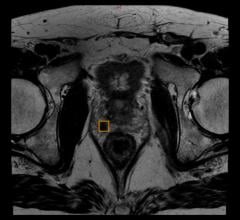
The Siemens Biograph mCT Flow PET/CT system.
Since entering the market in 2001, PET/CT (positron emission tomography/computed tomography) has come a long way in combining the benefits of individual PET and CT imaging. Last year saw the release of several new innovative technologies, marking improvements on previous generations of PET/CT, such as continuous data acquisition and bed motion, as well as higher image resolutions.
The basis of PET/CT is the fusion of anatomical and functional information acquired simultaneously by the hybrid scanner. By capturing anatomy from the CT and combining it with the functional processes observed through PET, physicians have more accurate information with which to diagnose or treat a patient. Furthermore, the resulting image is composed of co-registered scans, meaning they were acquired with the same protocols and with the added benefit of having the patient lying in the same position for both PET and CT modalities. And in a PET/CT, the CT portion provides attenuation correction for the image.
This hybrid modality brings significant advantages to both physicians and patients. Overall scan times are reduced, since the patient is undergoing just one session and not separate PET and CT examinations. It is also convenient for patients who may find going to two separate facilities or a facility twice for two different imaging scans an inconvenience. PET/CT also avoids challenges associated with attempting to fuse a PET image and CT image acquired at different times and possibly at different facilities, improving a physician’s chance of detecting malignant lesions or planning a life-saving radiation treatment plan for a patient.
New Systems Debut in 2013
When PET/CT emerged a little more than a decade ago, much of its limitations were similar to those faced by individual PET and CT. Today, advances across both modalities are increasing PET/CT capabilities and helping to improve efficiencies for hospitals and institutions that use the combined modality.
Dustin Osborne, Ph.D., an assistant professor in radiology and director of clinical research for the molecular imaging and translational research program at the University of Tennessee School of Medicine, described the state of its PET/CT program. “Over the past decade, our numbers have remained largely unchanged. With access to the latest technology along with moderate staffing adjustments, we have been able to increase our scheduling capacity by 50 percent and our average number of scans per day by nearly 44 percent.”
Osborne uses the latest offering from Siemens Healthcare, the Biograph mCT Flow PET/CT system, first introduced at the 2013 annual meeting of the Society of Nuclear Medicine and Molecular Imaging (SNMMI). Cleared by the U.S. Food and Drug
Administration (FDA), it features a new technology, FlowMotion, that moves the patient continuously through the system’s gantry, producing a more robust stream of data that is acquired in a single motion as opposed to previous stop-and-go iterations.
“FlowMotion uses a magnetically driven table and new data processing models, resulting in continuous bed motion throughout the entire procedure.” said Robert Brait, national product manager for PET/CT at Siemens’ Molecular Imaging Division. “Previously you would do a whole-body scan on a stop-and-go scanner, after which you may see that you need to do a high-resolution image of the head and neck or do some type of gating for the chest. Now, you can combine the high resolution of the head and neck, the gating to correct for motion in the chest and abdomen, and apply time-of-flight reconstruction to improve contrast in the pelvis,” he added.
Also unveiled in 2013 was the fully digital Vereos PET/CT system by Philips Healthcare. Released at the 2013 annual meeting of the Radiological Society of North America (RSNA), the Vereos is the first to use digital silicon photomultiplier detectors instead of traditional analog detectors, reportedly doubling the sensitivity gain, volumetric resolution and quantitative accuracy over that of analog systems. The system has received 510(k) clearance from the FDA.
Trends for the Future
The continuous bed motion feature found in Siemens’ FlowMotion technology has received
positive feedback thus far from patients and
physicians alike, said both Brait and Osborne. In a survey conducted by Osborne and his team at the University of Tennessee, physicians were found to prefer reading studies with data acquired by continuous bed motion versus data collected from step-and-shoot technologies.
“The center part of a PET scanner is the most sensitive and where you get the best resolution,” said Osborne. “With FlowMotion, every part of the patient passes through that central region at some point during the scan, and you get a uniform sensitivity profile across the entire axial extent of the scan. That helps to improve contrast for the physicians when they’re looking through the axial images.”
In April, GE Healthcare launched its Q.Clear PET/CT technology, which is designed to provide up to two times improvement in both quantitative accuracy and image quality. Current PET iterative reconstruction, such as time of flight (TOF) and OSEM, force a compromise between image quality and
quantitation. GE said its Q.Clear brings convergence without the need for compromise between quantitation and image quality.
The use of this hybrid modality is expected to grow in the coming years, particularly in radiation oncology, which comprises a majority of the volume of PET/CT imaging. “I think that’s an area where PET/CT is going to experience a tremendous amount of growth,” concluded Osborne.


 July 02, 2024
July 02, 2024 








